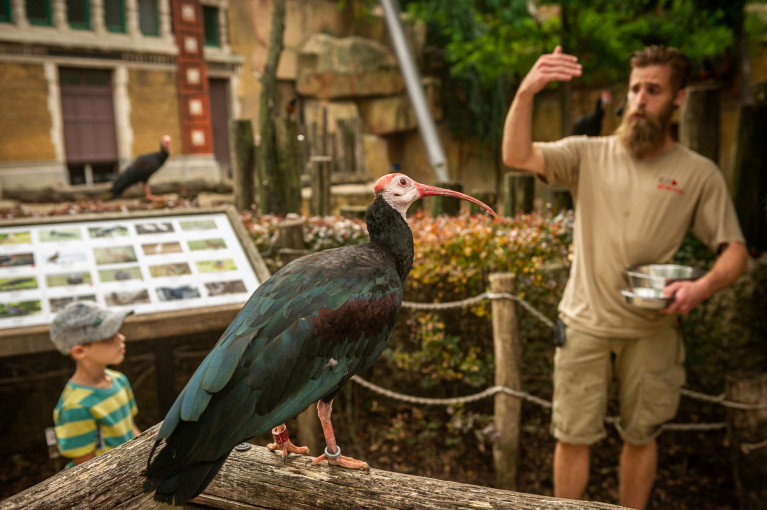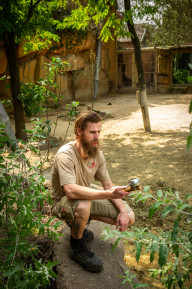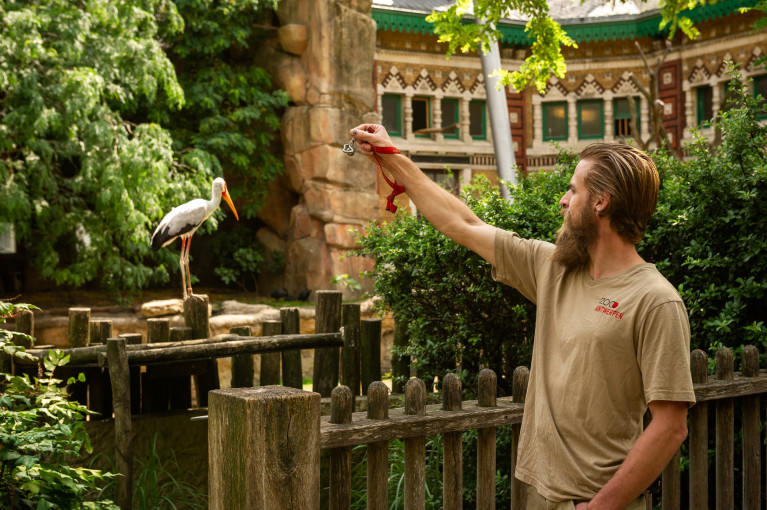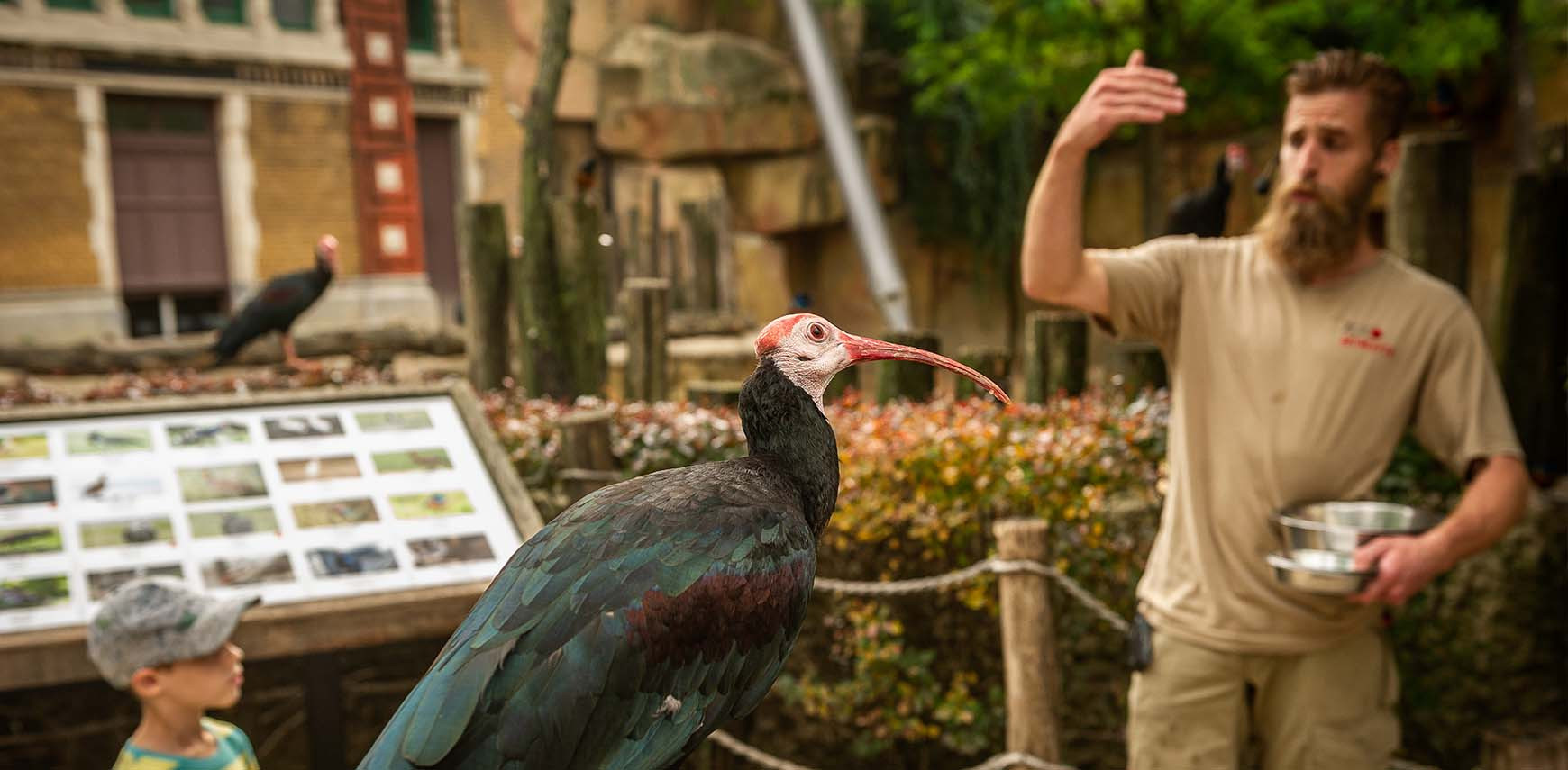An aviary that listens: recall training is huge success
The aviary of the future is located in the very heart of the City of Antwerp, at the edge of Antwerp ZOO. ‘We have 23 species of birds flying about in our Savannah Aviary, all of whom we can check up on individually due to our recall training,’ explains Jan Dams, Curator of Birds and Animal Care Coordinator. Thanks to months of training and the expertise built up by the zookeepers, each species now recognises a specific signal that prompts it to spread its wings and fly straight to its carers. This phenomenal project has had an indisputable impact on the zoo’s visitors, researchers and zookeepers and also the animals themselves.
‘Without recall training, it would be impossible to adequately check up on all the birds in the enormous Savannah Aviary. The walk-through aviary features an outdoor area of 2,000 m², a buffalo enclosure of 1,100 m² and six stories of indoor enclosures amounting to 530 m². Without these exercises, we would have to corral the birds in order to catch them, which is neither easy nor desirable. Our recall training happens voluntarily, pleasantly, and at the animals’ own pace. This in itself is already better for the animals’ wellbeing,’ explains Dams.
'Thanks to this training, we have excellent insight into the population, their health and even detect which birds are building'
He sees many more advantages: ‘On the one hand, we use our recall training to coax the animals into their indoor enclosure, the historic Rhino Building in our Savannah Aviary. (Many years ago, this building housed the first white rhinoceroses, but today it is home to between 200 and 250 African birds, birds of prey and a herd of Cape buffalo.) Once they are inside, it is easier for us to observe them, to give them care or shelter if necessary or to offer them protection from storms or wintry weather conditions. On the other hand, because we also do recall training outside, under the lofty nets of the Savannah Aviary, we have excellent insight into the population, can be sure that every animal is in optimum health and even detect which birds are building nests. The outdoor recall training programme is also a fantastic benefit for visitors to Antwerp ZOO. It means we can guarantee the animals’ visibility during our daily educational feeding presentation and give visitors a chance to see all the species in the aviary from close up.’
Interference and mood swings
Training the current inhabitants of the Rhino Building is, without a single doubt, a task of mammoth proportions for the team at the Savannah Aviary. Not only does the recall training programme take weeks, months or even years from start to finish, there are always plenty of complicating factors. Jasper Matthys, one of the zookeepers, explains: ‘The first factor we need to take into consideration is the weather. If the wind speed is over 11 knots, you will not find a single white-bellied stork willing to take flight for the reward of one little sprat.’ ‘The success of our training programme also varies from season to season. When the birds are in mating mode, many fewer yellow-billed storks will be willing to respond to your signal. And when they are nesting, we hold two separate sessions. That way the male can come first and then the female later on, so there is always someone guarding the nest.’

Less predictable factors can affect the training as well. Matthys continues: ‘Birds can also be quite susceptible to mood swings, particularly the Von der Decken’s hornbills. If they don’t feel like coming, they won’t, and that’s that. Even the moods of our zookeepers have an impact on the training. Every action you perform during a training session has an impact on the animals. If you don’t give your signal accurately enough or you do it in a hurry, this will affect the outcome of your training.’
Expertise and refinement
The experiences and observations gained during the recall training have also led to some specific choices with regard to the project. ‘Experience has taught us that when you’re training, it’s best to start with the more dominant animals, such as the yellow-billed storks or the European rollers,’ explains the curator of birds. The zookeepers agree: ‘If you were to train a hamerkop before a yellow-billed stork, the stork would most likely fly off with the hamerkop’s reward. A similar situation applies for the European rollers. These are extremely assertive by nature, and there is nothing they like better than to build their nests close to the pedestrian path. If you were to ask a hornbill to come anywhere near such a nest, you risk starting a fight between the two species. So, if we train and call away the European rollers first, we can get the hornbills to approach us without repercussions afterwards.’

‘Smarter’, more eager-to-learn species are also likelier to receive their training first. ‘Our rhinoceros hornbills, for example, are highly intelligent, and the superb starlings are always curious about what we’re doing. If we are rooting among twigs and bits of greenery, they’ll come and have a look. Because we already have their attention, that’s a perfect chance for us to start training them.’
Additionally, time and place are even more important than the trainers initially thought. Coordinator Jan Dams: ‘We regularly choose different places throughout the aviary for our recall training. This ensures that the birds don’t associate their reward with a specific place, but with their auditory signal. We also deliberately train them every day, several times a day, to make it less predictable for them. Suppose we were to condition them to come to us exclusively during the feeding presentation, then we would never be able to get them to go inside at unexpected moments. We want them to respond to our signal at any time.’
‘Our recall training programme here at the Savannah Aviary influences zoo management all over the world’
One step at a time
So, what exactly does such training involve? Zookeeper Jasper Matthys takes us through the steps of the recall training procedure.
- Habituation – First of all, we get the animals used to the presence of the zookeepers in their typical uniforms.
- Species-specific signals – Next, we select a specific auditory signal for each individual species. This can be just about anything: a bicycle bell, a jar filled with bottle caps, a whistle or a keyring. Each signal has to be distinctive enough to eliminate confusion, and clear enough for the birds to hear.
- Presenting the signal during feeding – ‘We stick to a very simple rule: the rewards the birds get during their training are given on top of their normal ration. We never withhold food from our animals. They will not go hungry if they do not complete a training session. That does not mean the reward is new to them. We only give food that is already part of their normal diet. Of course, we do save the tastiest bits for this purpose. Those can be mealworms, or blueberries, for example. If we notice a species responding particularly well to a certain type of food, we will choose that as their reward. We also give thought to how we present their reward. European rollers, for example, like catching their grasshoppers in mid-air. Spoonbills, on the other hand, prefer to fish their reward out of the water.
- Learning to associate their signal with a reward – In this step, the order is reversed. First, we present their signal. Then when the birds fly to us in response, they receive that tasty morsel as their reward.
- Varying locations - The zookeepers start their training at a fixed place, but as the programme progresses, they start varying locations; at different places within the aviary and, after a while, even indoors.
- Repeat! – This is probably the key element of the entire recall training process. Repetition is of crucial importance. ‘If you were to skip their training for a week, they will probably still understand what you want them to do, but if you were to stretch this, you will get increasingly ineffective results. During the pandemic, for example, we had to stop training because there were not enough zookeepers working in the Savannah Aviary. This was a real pity, because being able to get your animals to come to you by means of an efficient recall is particularly important in such times,’ says Jasper. This is why the birds receive training several times a day, every day. During the repeat stage, the zookeepers expand the recall training even further so that the birds know even better what is expected of them.
Impact on the international zoo community
The concept of recall training is applied in other zoos as well, says Jan Dams. ‘Still, being able to successfully perform recall training in a setting like this – in an aviary on this scale with so many animals – is truly unique. That’s why we care about sharing our expertise and experience. We encourage colleagues at other divisions in our zoo to look into the possibilities of this type of training programme. Our recall training has also had a considerable external impact. We are regularly invited to speak on the topic at conferences and have published several papers in professional journals. Colleagues from abroad often visit the Savannah Aviary to investigate whether recall training would be possible and feasible at their own zoos. In this way, our recall training programme here at the Savannah Aviary influences zoo management all over the world,’ concludes Dams.


